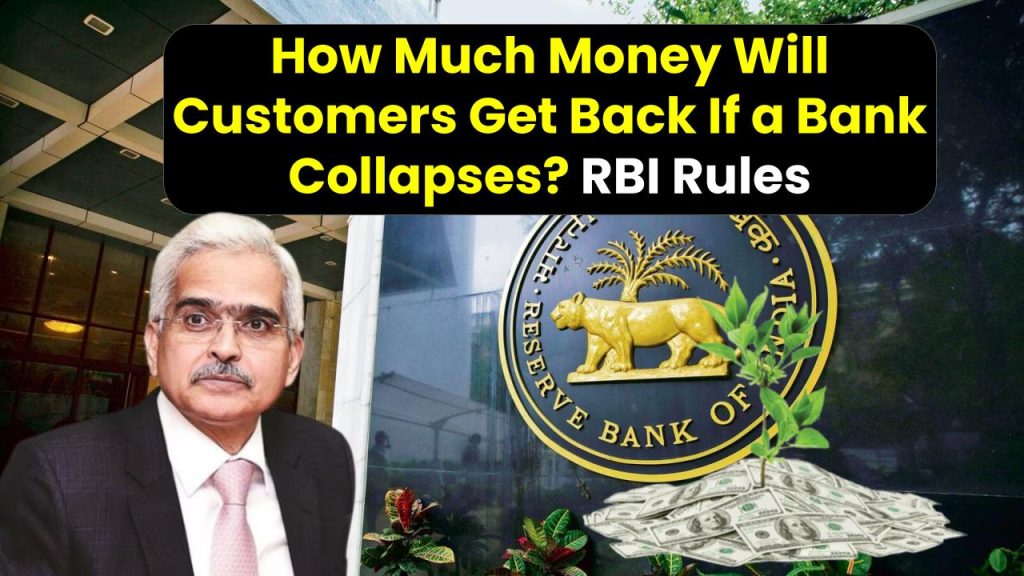
If you’ve ever wondered, “What happens to my money if the bank shuts down?”—you’re not alone. The Reserve Bank of India (RBI) has clear rules in place to protect depositors, even in the event of a bank failure. These rules are vital for every Indian citizen to understand, especially with rising concerns around banking fraud and financial stability.
Thanks to the Deposit Insurance and Credit Guarantee Corporation (DICGC)—a wholly-owned subsidiary of the RBI—you don’t lose everything if your bank collapses. But there are limits to how much you can get back, and those limits might surprise you.
Know What the RBI Rules
| Topic | Details |
|---|---|
| RBI Rule | Under DICGC, each depositor is insured up to ₹5 lakh per bank |
| Coverage Includes | Savings, Fixed, Current, and Recurring Deposits |
| Not Covered | Mutual funds, shares, bonds, debentures, locker contents |
| Premium Paid By | The bank (not the customer) |
| Claim Timeline | DICGC pays within 2 months of receiving the liquidation claim |
| Multiple Banks | ₹5 lakh insured per depositor, per bank |
Understanding how much money you’ll get back if a bank collapses is crucial for financial safety. Thanks to the RBI and DICGC, depositors are insured up to ₹5 lakh per bank. But if you have more funds, you should consider splitting them across multiple banks or using joint accounts for added protection.
What Is Deposit Insurance, and Why Does It Matter?
Imagine this: You’ve worked hard to save ₹10 lakh and placed it in a fixed deposit. Suddenly, the bank goes bust. Scary, right?
To protect depositors in such situations, the DICGC provides insurance coverage of up to ₹5 lakh, including both principal and interest, per depositor, per bank. This insurance acts like a safety net, ensuring at least a part of your hard-earned money is secure.
This ₹5 lakh limit was increased from ₹1 lakh in 2020, after the PMC Bank crisis led to public outcry. The update came after the Finance Minister’s announcement in the Union Budget 2020, ensuring stronger depositor protection.
see also: Sukanya Samriddhi Yojana Your Daughter Will Get ₹16,62,619
How Does This Work in Real Life?
Let’s say you have:
- ₹3 lakh in a savings account
- ₹2 lakh in a fixed deposit
Total: ₹5 lakh. If the bank collapses, you’re fully covered.
But if you had ₹7 lakh in total, only ₹5 lakh is insured, and you might lose the remaining ₹2 lakh unless recovered through legal proceedings.
Important tip: If you want to safeguard more than ₹5 lakh, spread your deposits across different banks. Each bank provides separate insurance up to the same ₹5 lakh cap.
What Kinds of Accounts Are Covered?
Here’s what’s covered under the DICGC insurance:
- Savings accounts
- Fixed deposits (FDs)
- Recurring deposits (RDs)
- Current accounts
Not covered:
- Mutual funds
- Stocks or bonds
- SIPs
- Locker contents
So if you’re only investing in market instruments or using lockers—know that DICGC won’t help there.
Who Pays the Insurance Premium?
Good news—you don’t need to pay a single rupee for this insurance.
The banks pay the premium to DICGC, and every commercial bank (public or private), foreign bank with Indian branches, and cooperative bank registered with RBI is mandatorily covered under this scheme.
In fact, according to the RBI’s DICGC Annual Report 2022-23, over 204 banks in India are part of this coverage network.
When Will You Get Your Money Back?
In case your bank is shut down or placed under moratorium (as was the case with Yes Bank or Lakshmi Vilas Bank), here’s how the process works:
- The RBI steps in and notifies DICGC.
- DICGC works with the bank’s liquidator to collect depositor data.
- Within 2 months, DICGC releases the insured amount to the liquidator.
- The liquidator disburses the money to depositors.
Usually, the payout is automatic—no separate claims required unless disputed.
Should You Be Worried About Bank Safety?
India’s banking system is largely stable. The RBI has strict capital adequacy, NPA monitoring, and governance frameworks to protect banks.
Still, occasional failures—especially among urban cooperative banks—highlight the importance of understanding deposit insurance. Over the last few years, several cooperative banks like Rupee Cooperative Bank and Guru Raghavendra Bank faced restrictions or collapse, affecting lakhs of depositors.
In fact, RBI recently considered a proposal to raise the ₹5 lakh limit even higher, acknowledging inflation and rising depositor concerns.
How to Maximize Your Protection – Expert Tips
Here’s how you can smartly manage your funds to stay fully protected:
1. Diversify Across Banks
Instead of putting ₹10 lakh in one bank, place ₹5 lakh in two banks. You’ll get full insurance on both—₹10 lakh total coverage.
2. Use Joint Accounts Wisely
Each co-holder in a joint account gets separate coverage. So, a joint account with two people can get up to ₹10 lakh insured.
3. Check the Bank’s Health
Keep an eye on:
- RBI circulars or restrictions
- Banks under PCA (Prompt Corrective Action)
- Unusual delays in transactions or service quality
see also: SBI, HDFC and Other Big Banks Are Offering Up to 8.05% Interest on FDs
Know What the RBI Rules FAQs
Q1. What happens if I have more than ₹5 lakh in one bank?
Only ₹5 lakh (including interest) is insured. The remaining amount is at risk unless recovered through liquidation or resolution.
Q2. Is the ₹5 lakh limit per account or per person?
It’s per depositor per bank, not per account. So even if you have multiple accounts in one bank, total insurance remains ₹5 lakh.
Q3. Can I claim the money myself?
You don’t need to apply separately. DICGC pays through the bank’s liquidator automatically after receiving depositor data.
Q4. Are cooperative banks covered?
Yes, cooperative banks registered with the RBI are included under DICGC insurance.
Q5. Will the deposit insurance limit be raised in the future?
The government is considering a raise beyond ₹5 lakh, but as of now, it’s not finalized.











